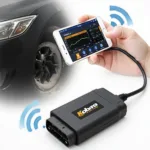The dreaded P0410 OBD2 code can be a real headache for car owners. This code indicates a problem with your vehicle’s Secondary Air Injection (SAI) system, a crucial part of your car’s emissions control. This article will delve into the P0410 code, its causes, symptoms, diagnostic procedures, and potential solutions, providing you with the knowledge you need to tackle this issue head-on.
What is the P0410 OBD2 Code?
The P0410 code signifies a malfunction within the Secondary Air Injection (SAI) system. This system injects fresh air into the exhaust manifold during cold starts, promoting a quicker catalytic converter warm-up and reducing harmful emissions. When the Powertrain Control Module (PCM) detects a problem with the SAI system’s airflow, it triggers the P0410 code.
Causes of the P0410 OBD2 Code
Several factors can contribute to a P0410 code. These include:
- Faulty SAI Pump: The SAI pump is responsible for delivering air to the exhaust. If the pump fails, the system cannot function correctly.
- Clogged or Damaged Air Injection Hoses: Cracks, leaks, or blockages in the hoses can restrict airflow and trigger the code.
- Malfunctioning SAI Control Valve: This valve regulates the flow of air into the system. A faulty valve can disrupt the proper operation of the SAI system.
- Wiring Issues: Damaged or corroded wiring within the SAI system can interrupt communication between components, leading to the P0410 code.
- Faulty Check Valve: A malfunctioning check valve might not prevent exhaust gases from backflowing into the SAI system, potentially damaging the pump.
- Blown Fuse: A blown fuse in the SAI system circuit will disable the system, setting the P0410 code.
Symptoms of a P0410 OBD2 Code
While the illuminated check engine light is the most obvious symptom, other indicators might include:
- Rough idling or stalling: The SAI system plays a role in cold start performance.
- Reduced fuel economy: Inefficient emissions control can impact fuel consumption.
- Increased emissions: The primary purpose of the SAI system is emission reduction, so a fault will likely lead to higher emissions.
- Hissing sound from the engine compartment: This could indicate a leak in the air injection hoses.
Diagnosing the P0410 OBD2 Code
Diagnosing the P0410 code involves a systematic approach:
- Retrieve the Code: Use an OBD2 scanner to confirm the P0410 code.
- Visually Inspect Components: Check the SAI pump, hoses, and valves for any visible damage or leaks.
- Check the Fuse and Relay: Verify the integrity of the fuse and relay associated with the SAI system.
- Test the SAI Pump: Use a multimeter to test the pump’s electrical connections and operation.
- Inspect the Hoses and Check Valve: Check for blockages or leaks in the hoses and ensure the check valve is functioning correctly.
Fixing the P0410 OBD2 Code
Depending on the diagnosed cause, the fix might involve:
- Replacing the SAI Pump: If the pump is faulty, replacement is often the only solution.
- Repairing or Replacing Hoses and Valves: Damaged hoses and valves should be repaired or replaced to restore proper airflow.
- Fixing Wiring Issues: Any damaged or corroded wiring needs to be repaired or replaced.
- Replacing the Check Valve: A malfunctioning check valve must be replaced.
- Replacing the Fuse: Replace a blown fuse with a new one of the correct amperage.
What Happens if You Ignore the P0410 OBD2 Code?
Ignoring the P0410 code can lead to:
- Failed emissions tests: Your vehicle may fail mandatory emissions testing.
- Further damage to the catalytic converter: Increased emissions can damage the catalytic converter.
- Decreased fuel economy: A malfunctioning SAI system can negatively impact fuel efficiency.
Conclusion
The P0410 OBD2 code, while concerning, is often manageable with proper diagnosis and repair. Understanding the SAI system, its components, and the potential causes of this code empowers you to address the issue efficiently. Don’t ignore this code. Taking prompt action can prevent further damage and ensure your vehicle runs smoothly and efficiently while adhering to emissions regulations.
FAQ
- What is the SAI system? The Secondary Air Injection system injects air into the exhaust to reduce emissions during cold starts.
- Can I drive with a P0410 code? While you can drive, it’s best to address the issue promptly to avoid further problems.
- How much does it cost to fix a P0410 code? The cost varies depending on the cause and required repairs.
- How can I prevent a P0410 code? Regular maintenance and inspections can help prevent SAI system issues.
- Is the P0410 code serious? While not immediately critical, ignoring it can lead to further damage and costly repairs.
- What tools do I need to diagnose a P0410 code? An OBD2 scanner is essential for retrieving the code and diagnosing the problem.
- Can a bad battery cause a P0410 code? While unlikely, a severely discharged battery can sometimes cause erratic readings and trigger codes.
Need support? Contact us via WhatsApp: +1(641)206-8880, Email: [email protected]. We have a 24/7 customer support team.


